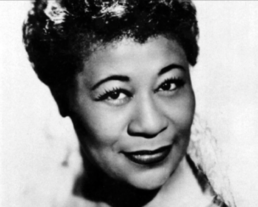These life stories may contain descriptions of childhood trauma and abuse, as well as images, voices and names of people now deceased. If you need help, you can find contact details for some relevant support services on our support page.
Legendary African American jazz singer, Ella Fitzgerald (1917-1996), was in kinship care and a reform school as a teenager.
Ella Jane Fitzgerald was born in Virginia. By the time Ella was almost three years old, her parents, William and Tempie (an abbreviation of Temperance), were living in New York City. Shortly after, William disappeared and Tempie began living with Joseph, or Joe, Da Silva in Yonkers, Westchester County, New York.
Ella went to the local Yonkers Public School for her primary education and Benjamin Franklin Junior High school for secondary. She appears to have been “an excellent student” (Nicolson). From early on Ella was known to love dancing and singing, particularly dancing. By the time she was fifteen, she was getting “dance jobs in the clubs around Yonkers” with her friend Charles Gulliver.
In 1932, Ella’s mother, Tempie, died suddenly of a heart attack at the age of thirty-eight. For a while, Ella stayed on with her half-sister Frances, and stepfather, but rumours started spreading that Joe wasn’t treating his stepdaughter well.
…whatever happened in Joe Da Silva’s household, it was sufficient for Tempie’s sister, Virginia, to step in abruptly and take Ella into her own family. (Nicolson p. 14).
Joe died not long after Tempie and then Frances, too, moved in with the girls’ aunt in Harlem. Over the next two years, Ella was difficult to get along with. She dropped out of school and began “running numbers…to make extra money”
The Mafia-run numbers racket, an illegal lottery, had been ubiquitous in Harlem and the adjacent black communities since the 1920s. Originally it was a chance for poor blacks…to have their pockets suddenly filled with cash. (Nicolson p. 15).
Running numbers and working as a lookout at brothels saw Ella caught by authorities and end up in the New York State Training School for Girls in Hudson, New York. She hated being there and ran away in 1934. Being unable to return to her aunt’s house because she might be caught, Ella was homeless for quite some time.
“When she ran away, she went from wayward girl to urchin, shuffling alone through the streets of Harlem, singing and dancing for small change, sleeping wherever she could find a night’s bed and board” (Jefferson cited by Immarigeon).
Determined to “make something” of herself, in November 1934 Ella entered and won a competition for new talent at the Apollo Theatre in Harlem. In January 1935 she won another competition at the Harlem Opera House, which was noted in the New York Age. Then an opportunity opened up for her in May that year when William “Chick” Webb (1905-1939) gave her a job as the vocalist for his band. The job lasted until Webb’s death, after which Ella Fitzgerald began recording and performing solo in theatres.
During the 1950s Ella Fitzgerald became a bestselling recording artist. She appeared on television and in films and continued to perform in theatres internationally. Ella Fitzgerald was awarded fourteen Grammy Awards, including the Grammy Lifetime Achievement Award in 1967. Amongst numerous other awards, she received an Honorary Doctorate from Harvard University in 1990 and the Presidential Medal of Freedom in 1992.
Ella Fitzgerald kept hidden for more than sixty years the more than twelve months she spent in the reformatory as a teenager, what Nina Bernstein calls “the cruelest chapter of her own history.”
References:
Bernstein, Nina. “Ward of the State. The Gap in Ella Fitzgerald’s Life.” New York Times, 23 June 1996.
Ella Fitzgerald. http://www.ellafitzgerald.com/
Immarigeon, Russ. “The “Ungovernable” Ella Fitzgerald.” Prison Public Memory Project, 29 October 2014. https://www.prisonpublicmemory.org/blog/2014/the-ungovernable-ella-fitzgerald
Nicolson, Stuart. Ella Fitzgerald: A Biography of the First lady of Jazz. Routledge, Updated Edition, 2004.
Image available here.
